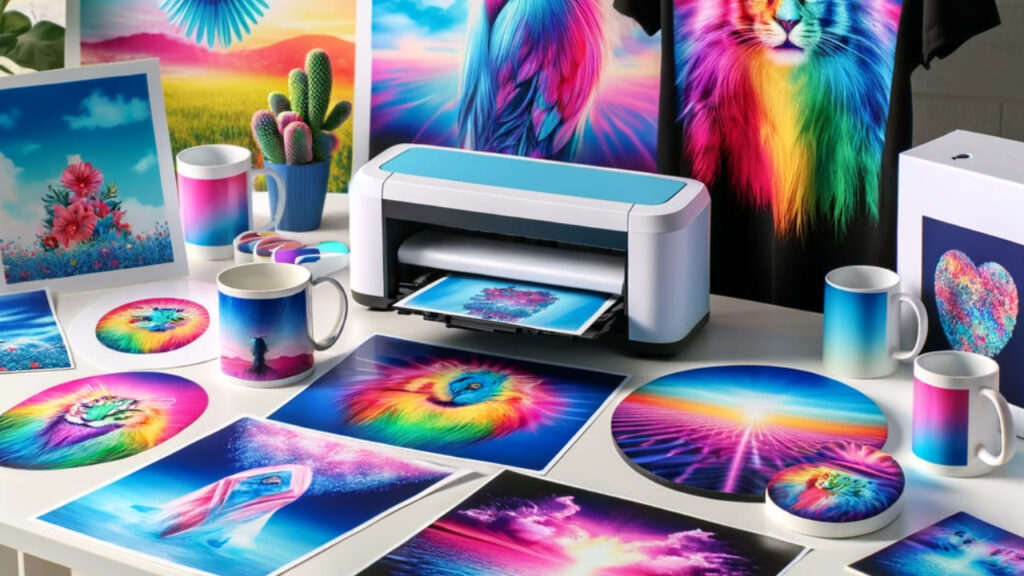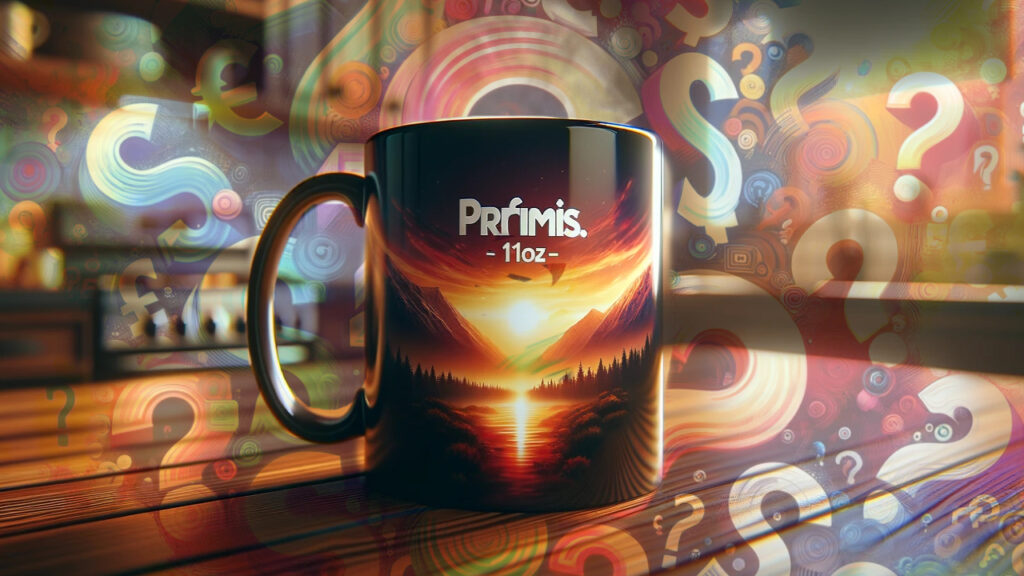What is Dye Sublimation?
Dye Sublimation is the method of transferring Ink (Dye) into products such as Mugs, Mouse Mats and other suitable materials. When I first came across Dye Sublimation was at a ‘Printwear and Promotion‘ event at Birmingham many many years ago.
I remember seeing a company (Sawgrass) making Promotional NEMO Mugs with this technology and was absolutely blown away by the quality and the ease of use.

Move forward 20 years and not only is Dye Sublimation still being used on Mugs, but the range of products now suitable for sublimation has grown exponentially.
How does it work?
In a nutshell the process is incredibly simple (the technology not so much), and involves a user printing a design using Dye Sublimation Inks onto a heavy duty piece of transfer paper (heavy duty paper is required due to the amount of ink that needs to be used). The paper is then placed onto a suitable product and heated to 200c.
Once the ink hits 200c, the ink is then transferred onto the product.
Dye Sublimation Process
Let’s take the most popular “Personalised Mugs“. They are often to go to product for anybody looking to start a personalised printing business. To make a personalised mug the process is:
#1 Design your Mug
Using specifically calibrated software such as Corel Draw, create your design ensuring the sizing matches the mugs printable area and that the design is mirrored (reversed) prior to clicking print.
#2 Printing
Print the design onto suitable transfer paper using Sublimation inks and leave to fully dry (no smudges!).
#3 Application
Cut the paper to the approximate size of and carefully wrap the transfer paper around the mug ensuring it is level. Once in position tape both ends with heat tape. (using normal tape will melt/burn and ultimately damage your product).
#4 Pressing
Heat your mug press to 200c and set the timer for 2 minutes. Once heated, place the mug with it’s handle facing out of the press and clamp the press ensuring even the transfer paper has not creased or crumpled. After 2 minutes, carefully remove the mug and transfer paper.
#5 Leave to Cool
Personally, I prefer to put my mugs into a bucket of cold water to instantly cool, however leaving them out next to an open window works absolutely fine and does not run the risk of cracking the mug.
What Equipment do I need?
The equipment required will be dependant on the type of personalised gifts you wish to create. For any form of Dye Sublimation you do need both the printer with Dye Sublimation Inks and a Heat Press.
Heat Press
Heat presses come in many shapes and sizes but they can all be categorised as either a mug press, or a flatbed heat press. Flatbed heat presses are often a better purchase as you can also use them with HTV Vinyl to make print wear.
| Mugs & Cylindrical Products | Mug Heat Press |
| T-shirts / Coasters / Mouse Mats / Keyrings | Flatbed Heat Press |
Heat Press Size Considerations
Choosing a heat press should ideally be future-proof. A smaller press with be cheaper, but does limit your ability to sublimate larger items or multiple items at the same time. A larger press will future-proof you, costs more in electricity to heat up a large platen compared to a smaller press.
Heat Press Style Considerations
The style of heat press will also decide what products you’re able to make. The 2 main styles are:

Clam heat presses are not really suitable for dye sublimation due to the way the press closes. Clam heat presses may disrupt the transfer paper as they are closed.
- Clam Heat Presses
- Swing Heat Presses
Sublimation products need a vertical press which means ideally you should be looking at “Swing Heat Presses”. Clam heat presses can technically still be used, but thicker items such as mouse mats / thick drink coasters will have uneven heat applied causing problems in the final product.
Dye Sublimation Printer
It’s a common misconception that you need a specific printer to print with Dye Sublimation Inks, however depending on your supplier you may be limited to the types of cartridges they support which does somewhat corner you into the printer model you should purchase.
Personally, I find the whole situation incredibly frustrating and still have several Epson Printers stored in my shop which I can no longer purchase Dye Sublimation Ink Cartridges or Bulk Ink systems for as the suppliers deemed them to be “old technology”.
Dye Sublimation Ink

Ink plays a key role in the quality of your finished product. The main brands for Sublimation Ink are:
- Sawgrass
- Ricoh
Both of these manufacturers offer excellent image quality and with that comes higher prices. You “can” purchase cheaper ink from other manufacturers, however you will notice that your sublimation prints are not matching skin tone colours correctly and they will most likely appear faded when compared to the premium inks.
Products you can make
Compared to many years ago when Sublimation was just hitting the UK with only 3 ink manufacturers (Sawgrass, Tropical Graphics, Lyson) the range of Sublimation products has grown exponentially. This is absolutely fantastic for the industry and does allow you to hit a niche type of business which specialises in a specific product. For example, our site UFO Slurp offers only Sublimated Mugs, and focuses on the UFO / Paranormal genre.

If you don’t fancy making mugs, then the list really is endless with countless opportunities to upsell or increase your range:
- Mugs
- Mouse Mats
- Coasters
- Keyrings
- Hats
- T-Shirts
- Tote Bags
- Aprons
- Phone Cases
- etc etc etc
A question often asked is “Can I sublimate anything?“, and the answer is No. Sublimation requires a specific sublimation product that has the polyester based coating designed to absorb the ink. In fact, back when I was trying this out for myself I tried using products that were not designed for sublimation but were much cheaper – and nothing worked 🤣
Advantages of Dye Sublimation
Personalisation
The main advantage has to be the personalisation level this system offers. Not only can you make commercially branded merchandise, but you can also make unique photo mugs at a fraction of the price when compared to companies like Zazzle or Cafépress.
Stock
Your stock will just be blank substrates and you make each item to order as and when you receive an order. This means your money is not tied up in products that may or may not sell. In some circumstances, if you’re noticing great demand for a specific design – you can pre-print some products – but as production takes only a few minutes there really is no need.
Durability
Dye sublimation still amazes me at the level of durability. A T-Shirt I made back in 2005 is still going strong to this day. The design has not faded and still washes and wears absolutely fine. The same goes for mugs which have been through the dishwasher hundreds of times without any signs of fading.
Creative Freedom
One size doesn’t fit all, and tied with printing to order you can offer your customers changes to their final products (border colour, text colour, image changes) very quickly without affecting too much of your workflow.
Disadvantages of Dye Sublimation
Product Limitations
Event though as I’ve already mentioned the range of products is fairly huge – you are still limited to what products you can sublimate. A fine example is somebody wanting their photo on a black t-shirt. Although this can be achieved, you first need to print onto some Dark Transfer paper and then apply the paper to the T-Shirt.
From my own experience, the quality and feel of the final product is not as good and does end up cracking/peeling over time. I often refer to it as “wearing a cereal box on your chest“.
Mistakes
Like any other product, mistakes can happen. But with Sublimation they can turn out to be fairly costly with no way to reverse. I love mugs, but in the same breath, they have caused me more stress than enough. A mug which has not been evenly fired in the Kiln will have small imperfections. These imperfections show on the final product if not checked and refused prior to production.
Dye Sublimation Ink
High Quality Dye Sublimation Ink is not cheap and if you’re not printing every day can cause your print heads to block. I still have nightmares printing large mouse mat designs where a nozzle became blocked at the end of the print which then requires the full maintenance of cleaning and re-printing costing both money and time.
Smell
Dye Sublimation works by infusing the ink into sublimation products and with that comes the smell. Personally, I don’t mind it. However when you’re printing 30-100 mouse mats proper ventilation is essential.
How much Money can I make using Dye Sublimation
As mentioned previously the type of product you are selling will have an impact into your profit margins, but for the sake of this introduction let’s look at a standard mouse mat.
| Blank Mouse Mat | 50p |
| Full Colour Print | £1.00 |
| Time to Print | 3 Minutes |
| Time to Press | 2 Minutes (inc prep time) |
| Total Cost | £1.50 |
| Selling Price | £9.99 |
| Profit | £8.49 |
The final profit does not take into account the time it takes to design the product, but imagine making 10 mouse mats per day 5 days a week. That’s £22,074 per year profit just on mouse mats!
Final Thoughts
Dye Sublimation is a fantastic system to create personalised gifts and offers incredible markups at the fraction of the cost when compared to screen printing for small runs. I still get a thrill seeing the final product coming out of the press and know for a fact the customer will be happy.
My advice, go for a high quality ink and high quality products. Educate your customers about the difference between ‘cheap’ and ‘premium’. Preparation is key and ensuring your working environment is clean will help keep the quality of your products in tip top condition.

